#use of ai and robotics in healthcare industry
Explore tagged Tumblr posts
Text
AI in Healthcare: Automating Tasks to Personalizing Treatments

The healthcare industry is currently on the cusp of a revolution- this time, driven by AI. From automating healthcare-related administrative tasks to assisting in groundbreaking medical procedures and discoveries, AI is changing the game, and very efficiently. It is rapidly changing the way we understand, diagnose, and treat health.
Since the entire world is performing half of their daily tasks like connecting with people across the continent, paying their bills, and purchasing groceries through apps, how can the healthcare industry stay behind? Healthcare mobile app development is all the rage now- at least among people who understand the futuristic implications of healthcare combined with AI.
In 2024, the AI in Healthcare market is expected to touch a whopping $67.6 billion (the potential!) worldwide. But do you understand what exactly AI brings to the table in the healthcare arena? Read ahead to understand how AI is driving the healthcare industry, and how you can tap into this potential too.
AI In Healthcare: The Implications

AI in healthcare refers to using certain Artificial Intelligence technologies like software or apps that help enhance various arenas of the healthcare industry. Various aspects of AI help to understand and analyze the medical data already available to facilitate clinical decision-making and even assist in diagnosis.
While AI is not widely implemented in healthcare today, it does have promising and positive implications, some of which are:
Automated Tasks:
A lot of tasks in the healthcare domain can be automated with the help of AI. This involves a lesser burden on already overworked staff at hospitals and clinics where there is usually a huge number of patients, and it is difficult to keep up.
Reduced Healthcare Costs:
One of the biggest implications of leveraging AI in healthcare is reduced healthcare costs. Though the costs wouldn’t come down drastically, AI can help by reducing the time required for consulting specialized healthcare professionals, thus cutting down costs around it.
Personalized Mental Healthcare:
One example of how AI can help in healthcare can be seen in the case of mental health. Over the past couple of years, many tools have come up that are helping people take care of their mental health. These include chatbots that are available to converse with, anytime; along with guided meditation and maintaining all the data that is fed into the app.
The Best Examples of AI In Healthcare
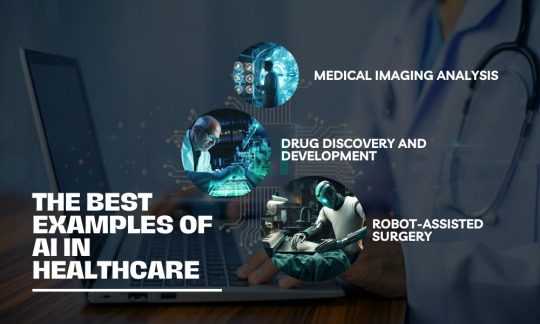
While you wonder about how you can tap into the potential of AI in the Healthcare market, here are some of the best examples of AI in use in the healthcare niche:
Medical Imaging Analysis:
AI models are currently being trained to analyze medical images like X-rays and different types of scans, like CT and MRIs, to assist radiologists in detecting any abnormalities, like tumors or fractures.
For example, Paige.AI can use mammograms to detect any signs of breast cancer.
Drug Discovery And Development:
Traditional drug discovery processes are both money and time-consuming. AI can help accelerate this process by analyzing vast amounts of data to identify potential drug targets and predict the effectiveness of new drugs by analyzing the action of the present components.
For Example, Benevolent AI uses patient data to analyze and predict alternate treatment options for different diseases.
Robot-Assisted Surgery:
Surgical robots guided by AI algorithms have an elevated precision, helping to reduce complications in complex surgical procedures. With enhanced dexterity, surgeons can now perform minimally invasive procedures with better precision.
Use Cases: AI In Healthcare

It might be worth it to ponder upon the cases and situations where AI can be leveraged. This is also the starting point where you begin to think of ideas that might help you break into the market with another app catering to healthcare. Some of these use cases are:
Administrative Efficiency:
Administrative processes take up a lot of time in the healthcare arena.
The use of AI to automate processes like patient registration, appointment scheduling, cancellation, rescheduling, patient data retrieval, insurance claims, generating patient reports etc., can easily be handed over to AI, thus freeing up more time for healthcare professionals to tend to more patients.
Disease Prediction And Prevention:
Often, the correct use of previous data to train any AI model can help to correctly diagnose, and even predict the progression of a disease by analyzing patterns.
Remote Patient Monitoring:
AI-powered wearables and sensors can continuously monitor a patient’s health data and even offer real-time updates and data on how the patient is progressing with the disease.
Drug Dosage Optimization:
For certain patients, after analyzing their health and lab tests, it can be gauged what dosage of a drug would be effective for them. This also partly falls under the arena of personalized healthcare but also deals with already existing drug compositions.
Benefits Of AI In Healthcare
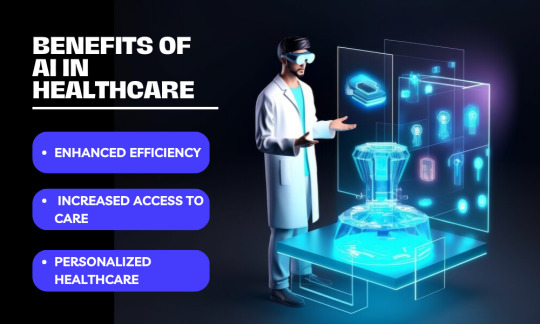
Now when you understand the use cases of AI in Healthcare, it only seems fair to see how beneficial it currently is, and the potential it shows for the future. These benefits apply to doctors, patients, and the entire healthcare system as a whole:
Enhanced Efficiency:
Leveraging AI in the healthcare arena has only proven beneficial, from drug dosage optimization to automating tasks streamlining workflows, and helping patients to understand their health symptoms, AI has been able to bring out efficiency, not just in hospitals, but the overall healthcare arena.
Increased Access To Care:
Patients no longer need to stand waiting in a call for someone to check and inform them of an empty slot to book an appointment, AI can do it for them. Imagine seeing real-time scheduling slots for a healthcare professional, whom anyone can access.
Also, children who do not have an adult nearby can also use AI to identify the symptoms they are having, and AI can automatically inform the nearest hospital of the same as well.
Personalized Healthcare:
This is one of the most revolutionary things that AI is involved within healthcare. Each has different needs regarding healthcare and treatments.
AI is currently being used to study the medical data and patterns of individuals that can benefit them by making up a treatment plan for them that is tailored to their needs.
Conclusion
While AI is not a replacement for human healthcare professionals, it can certainly be used to assist healthcare professionals in diagnosis, data analysis and treatment for patients.
Beyond the hospitals too, AI is being used in pharmaceutical industries in drug designing and more, as well as in medical research, to better understand disease progression and how AI can help by understanding the progression patterns and more.
As for someone looking to tap into this market, you can always identify niches in healthcare where the use of AI can be leveraged well, and since everything has gone mobile today, invest in a mobile apps development agency tailored for that particular niche. With time, you can break into the market and benefit many patients in the process.
#Healthcare mobile app development#healthcare industry#Custom App Development#AI In Healthcare#Artificial Intelligence technologies#AI in healthcare is reduced healthcare costs#Surgical robots#Use Cases: AI In Healthcare#Benefits Of AI In Healthcare#healthcare app development company#healthcare mobile app development#healthcare app developers
0 notes
Text
Pluto in Aquarius: Brace for a Business Revolution (and How to Ride the Wave)
The Aquarian Revolution
Get ready, entrepreneurs and financiers, because a seismic shift is coming. Pluto, the planet of transformation and upheaval, has just entered the progressive sign of Aquarius, marking the beginning of a 20-year period that will reshape the very fabric of business and finance. Buckle up, for this is not just a ripple – it's a tsunami of change. Imagine a future where collaboration trumps competition, sustainability dictates success, and technology liberates rather than isolates. Aquarius, the sign of innovation and humanitarianism, envisions just that. Expect to see:
Rise of social impact businesses
Profits won't be the sole motive anymore. Companies driven by ethical practices, environmental consciousness, and social good will gain traction. Aquarius is intrinsically linked to collective well-being and social justice. Under its influence, individuals will value purpose-driven ventures that address crucial societal issues. Pluto urges us to connect with our deeper selves and find meaning beyond material gains. This motivates individuals to pursue ventures that resonate with their personal values and make a difference in the world.
Examples of Social Impact Businesses
Sustainable energy companies: Focused on creating renewable energy solutions while empowering local communities.
Fair-trade businesses: Ensuring ethical practices and fair wages for producers, often in developing countries.
Social impact ventures: Addressing issues like poverty, education, and healthcare through innovative, community-driven approaches.
B corporations: Certified businesses that meet rigorous social and environmental standards, balancing profit with purpose.
Navigating the Pluto in Aquarius Landscape
Align your business with social impact: Analyze your core values and find ways to integrate them into your business model.
Invest in sustainable practices: Prioritize environmental and social responsibility throughout your operations.
Empower your employees: Foster a collaborative environment where everyone feels valued and contributes to the social impact mission.
Build strong community partnerships: Collaborate with organizations and communities that share your goals for positive change.
Embrace innovation and technology: Utilize technology to scale your impact and reach a wider audience.
Pluto in Aquarius presents a thrilling opportunity to redefine the purpose of business, moving beyond shareholder value and towards societal well-being. By aligning with the Aquarian spirit of innovation and collective action, social impact businesses can thrive in this transformative era, leaving a lasting legacy of positive change in the world.
Tech-driven disruption
AI, automation, and blockchain will revolutionize industries, from finance to healthcare. Be ready to adapt or risk getting left behind. Expect a focus on developing Artificial Intelligence with ethical considerations and a humanitarian heart, tackling issues like healthcare, climate change, and poverty alleviation. Immersive technologies will blur the lines between the physical and digital realms, transforming education, communication, and entertainment. Automation will reshape the job market, but also create opportunities for new, human-centered roles focused on creativity, innovation, and social impact.
Examples of Tech-Driven Disruption:
Decentralized social media platforms: User-owned networks fueled by blockchain technology, prioritizing privacy and community over corporate profits.
AI-powered healthcare solutions: Personalized medicine, virtual assistants for diagnostics, and AI-driven drug discovery.
VR/AR for education and training: Immersive learning experiences that transport students to different corners of the world or historical periods.
Automation with a human touch: Collaborative robots assisting in tasks while freeing up human potential for creative and leadership roles.
Navigating the Technological Tsunami:
Stay informed and adaptable: Embrace lifelong learning and upskilling to stay relevant in the evolving tech landscape.
Support ethical and sustainable tech: Choose tech products and services aligned with your values and prioritize privacy and social responsibility.
Focus on your human advantage: Cultivate creativity, critical thinking, and emotional intelligence to thrive in a world increasingly reliant on technology.
Advocate for responsible AI development: Join the conversation about ethical AI guidelines and ensure technology serves humanity's best interests.
Connect with your community: Collaborate with others to harness technology for positive change and address the potential challenges that come with rapid technological advancements.
Pluto in Aquarius represents a critical juncture in our relationship with technology. By embracing its disruptive potential and focusing on ethical development and collective benefit, we can unlock a future where technology empowers humanity and creates a more equitable and sustainable world. Remember, the choice is ours – will we be swept away by the technological tsunami or ride its wave towards a brighter future?
Decentralization and democratization
Power structures will shift, with employees demanding more autonomy and consumers seeking ownership through blockchain-based solutions. Traditional institutions, corporations, and even governments will face challenges as power shifts towards distributed networks and grassroots movements. Individuals will demand active involvement in decision-making processes, leading to increased transparency and accountability in all spheres. Property and resources will be seen as shared assets, managed sustainably and equitably within communities. This transition won't be without its bumps. We'll need to adapt existing legal frameworks, address digital divides, and foster collaboration to ensure everyone benefits from decentralization.
Examples of Decentralization and Democratization
Decentralized autonomous organizations (DAOs): Self-governing online communities managing shared resources and projects through blockchain technology.
Community-owned renewable energy initiatives: Local cooperatives generating and distributing clean energy, empowering communities and reducing reliance on centralized grids.
Participatory budgeting platforms: Citizens directly allocate local government funds, ensuring public resources are used in line with community needs.
Decentralized finance (DeFi): Peer-to-peer lending and borrowing platforms, bypassing traditional banks and offering greater financial autonomy for individuals.
Harnessing the Power of the Tide:
Embrace collaborative models: Participate in co-ops, community projects, and initiatives that empower collective ownership and decision-making.
Support ethical technology: Advocate for blockchain platforms and applications that prioritize user privacy, security, and equitable access.
Develop your tech skills: Learn about blockchain, cryptocurrencies, and other decentralized technologies to navigate the future landscape.
Engage in your community: Participate in local decision-making processes, champion sustainable solutions, and build solidarity with others.
Stay informed and adaptable: Embrace lifelong learning and critical thinking to navigate the evolving social and economic landscape.
Pluto in Aquarius presents a unique opportunity to reimagine power structures, ownership models, and how we interact with each other. By embracing decentralization and democratization, we can create a future where individuals and communities thrive, fostering a more equitable and sustainable world for all. Remember, the power lies within our collective hands – let's use it wisely to shape a brighter future built on shared ownership, collaboration, and empowered communities.
Focus on collective prosperity
Universal basic income, resource sharing, and collaborative economic models may gain momentum. Aquarius prioritizes the good of the collective, advocating for equitable distribution of resources and opportunities. Expect a rise in social safety nets, universal basic income initiatives, and policies aimed at closing the wealth gap. Environmental health is intrinsically linked to collective prosperity. We'll see a focus on sustainable practices, green economies, and resource sharing to ensure a thriving planet for generations to come. Communities will come together to address social challenges like poverty, homelessness, and healthcare disparities, recognizing that individual success is interwoven with collective well-being. Collaborative consumption, resource sharing, and community-owned assets will gain traction, challenging traditional notions of ownership and fostering a sense of shared abundance.
Examples of Collective Prosperity in Action
Community-owned renewable energy projects: Sharing the benefits of clean energy production within communities, democratizing access and fostering environmental sustainability.
Cooperatives and worker-owned businesses: Sharing profits and decision-making within companies, leading to greater employee satisfaction and productivity.
Universal basic income initiatives: Providing individuals with a basic safety net, enabling them to pursue their passions and contribute to society in meaningful ways.
Resource sharing platforms: Platforms like carsharing or tool libraries minimizing individual ownership and maximizing resource utilization, fostering a sense of interconnectedness.
Navigating the Shift
Support social impact businesses: Choose businesses that prioritize ethical practices, environmental sustainability, and positive social impact.
Contribute to your community: Volunteer your time, skills, and resources to address local challenges and empower others.
Embrace collaboration: Seek opportunities to work together with others to create solutions for shared problems.
Redefine your own path to prosperity: Focus on activities that bring you personal fulfillment and contribute to the collective good.
Advocate for systemic change: Support policies and initiatives that promote social justice, environmental protection, and equitable distribution of resources.
Pluto in Aquarius offers a unique opportunity to reshape our definition of prosperity and build a future where everyone thrives. By embracing collective well-being, collaboration, and sustainable practices, we can create a world where abundance flows freely, enriching not just individuals, but the entire fabric of society. Remember, true prosperity lies not in what we hoard, but in what we share, and by working together, we can cultivate a future where everyone has the opportunity to flourish.
#pluto in aquarius#pluto enters aquarius#astrology updates#astrology community#astrology facts#astro notes#astrology#astro girlies#astro posts#astrology observations#astropost#astronomy#astro observations#astro community#business astrology#business horoscopes
121 notes
·
View notes
Text
AI & IT'S IMPACT
Unleashing the Power: The Impact of AI Across Industries and Future Frontiers
Artificial Intelligence (AI), once confined to the realm of science fiction, has rapidly become a transformative force across diverse industries. Its influence is reshaping the landscape of how businesses operate, innovate, and interact with their stakeholders. As we navigate the current impact of AI and peer into the future, it's evident that the capabilities of this technology are poised to reach unprecedented heights.
1. Healthcare:
In the healthcare sector, AI is a game-changer, revolutionizing diagnostics, treatment plans, and patient care. Machine learning algorithms analyze vast datasets to identify patterns, aiding in early disease detection. AI-driven robotic surgery is enhancing precision, reducing recovery times, and minimizing risks. Personalized medicine, powered by AI, tailors treatments based on an individual's genetic makeup, optimizing therapeutic outcomes.
2. Finance:
AI is reshaping the financial industry by enhancing efficiency, risk management, and customer experiences. Algorithms analyze market trends, enabling quicker and more accurate investment decisions. Chatbots and virtual assistants powered by AI streamline customer interactions, providing real-time assistance. Fraud detection algorithms work tirelessly to identify suspicious activities, bolstering security measures in online transactions.
3. Manufacturing:
In manufacturing, AI is optimizing production processes through predictive maintenance and quality control. Smart factories leverage AI to monitor equipment health, reducing downtime by predicting potential failures. Robots and autonomous systems, guided by AI, enhance precision and efficiency in tasks ranging from assembly lines to logistics. This not only increases productivity but also contributes to safer working environments.
4. Education:
AI is reshaping the educational landscape by personalizing learning experiences. Adaptive learning platforms use AI algorithms to tailor educational content to individual student needs, fostering better comprehension and engagement. AI-driven tools also assist educators in grading, administrative tasks, and provide insights into student performance, allowing for more effective teaching strategies.
5. Retail:
In the retail sector, AI is transforming customer experiences through personalized recommendations and efficient supply chain management. Recommendation engines analyze customer preferences, providing targeted product suggestions. AI-powered chatbots handle customer queries, offering real-time assistance. Inventory management is optimized through predictive analytics, reducing waste and ensuring products are readily available.
6. Future Frontiers:
A. Autonomous Vehicles: The future of transportation lies in AI-driven autonomous vehicles. From self-driving cars to automated drones, AI algorithms navigate and respond to dynamic environments, ensuring safer and more efficient transportation. This technology holds the promise of reducing accidents, alleviating traffic congestion, and redefining mobility.
B. Quantum Computing: As AI algorithms become more complex, the need for advanced computing capabilities grows. Quantucm omputing, with its ability to process vast amounts of data at unprecedented speeds, holds the potential to revolutionize AI. This synergy could unlock new possibilities in solving complex problems, ranging from drug discovery to climate modeling.
C. AI in Creativity: AI is not limited to data-driven tasks; it's also making inroads into the realm of creativity. AI-generated art, music, and content are gaining recognition. Future developments may see AI collaborating with human creators, pushing the boundaries of what is possible in fields traditionally associated with human ingenuity.
In conclusion, the impact of AI across industries is profound and multifaceted. From enhancing efficiency and precision to revolutionizing how we approach complex challenges, AI is at the forefront of innovation. The future capabilities of AI hold the promise of even greater advancements, ushering in an era where the boundaries of what is achievable continue to expand. As businesses and industries continue to embrace and adapt to these transformative technologies, the synergy between human intelligence and artificial intelligence will undoubtedly shape a future defined by unprecedented possibilities.
19 notes
·
View notes
Text
I'm honestly so furious right now. I work in a video and photography department for a large healthcare organization. We're a department of 9, plus an intern. We're under the "marketing" umbrella, though we do a lot more than marketing for the network (for example we also make patient and employee education videos/photos/animations).
Yesterday the social media department (also part of marketing. We supply photos and videos for them to post) posted an AI generated image on our company's instagram page. It was a photorealistic AI image of a baby, used to promote our pediatric cardiology service line. The image is so ridiculously obviously AI, it makes me want to puke. It's uncanny, too smooth with zero skin texture, the eyes are messed up, and the "baby" literally has full eyelashes on one eye and none on the other.
I'm livid because it's like... what the fuck do they need OUR department for if they're going to be using AI now?
To our knowledge, this is the first time they've done this. I get that there's an "argument" to be made that it's incredibly difficult and time consuming to set up a photoshoot with a real baby, and they wanted something fast and easy because the marketing service line directors are constantly on social media's ass to push out abhorrent amounts of marketing content on social media. This culture will never change. We've tried to explain that people don't like seeing constant mediocre ads for healthcare service lines when they are on social media. But the higher ups won't listen to that AT ALL. So... AI generated gross ass baby it is (I cannot stress enough how creepy this "baby" looks).
But it's a slippery slope. Because first it's a baby. Next it'll be a fake orthopedic surgery patient because who has time to find a real patient for our photographers to shoot? Never mind that people on social media actually DO like seeing real patient stories. Next it'll be a billboard on the highway with AI generated doctors because who cares to know what their real doctor looks like, right? This is making me so mad for the photographers in my department who work so fucking hard to shoot and edit stunning, quality images. Their jobs will be relegated to event photography until someday an unmanned robot can set up their own camera and do that too (they probably already can?).
Recently one of the service line directors in marketing asked me to use an AI voice for an animation I'm making. I had to put my foot down and say that we have three fantastic local voiceover artists who we use for these kinds of projects. One of them is a retired gentleman who went to school with my dad and is always extremely happy to get work from us. Sometimes I think these marketing people just want to use AI because it's trendy.
I understand that there are other industries and individuals who are already being massively affected by AI to a much larger and much more detrimental degree. And that my problems are largely me spinning out of control. I figured AI would hit us eventually, and there's really nothing I can do except continue to put my foot down about the voiceover thing. I can't do much for the photographers, sadly. I'm too nervous to get mad at social media, though I really wish I could at least point out how disgusting that baby looks. But I'm worried that I'm going to be some sort of pariah if I voice my opinion on it. I already get paid peanuts and there's really no way for me to advance my career here. So being the "person who shits on social media for using AI" might be detrimental to me in the long run. I really DO want to advocate for our photographers, but is it my place? Idk, it's complicated.
#what do i even tag this?#personal post for ts;#zuzu note;#ai for ts#tw ai#I don't know if people blacklist that kind of thing#I feel like you can't because ai is a common ummm combination of letters in words?#but just in case
11 notes
·
View notes
Text
What is Artificial Intelligence?? A Beginner's Guide to Understand Artificial Intelligence
1) What is Artificial Intelligence (AI)??
Artificial Intelligence (AI) is a set of technologies that enables computer to perform tasks normally performed by humans. This includes the ability to learn (machine learning) reasoning, decision making and even natural language processing from virtual assistants like Siri and Alexa to prediction algorithms on Netflix and Google Maps.
The foundation of the AI lies in its ability to simulate cognitive tasks. Unlike traditional programming where machines follow clear instructions, AI systems use vast algorithms and datasets to recognize patterns, identify trends and automatically improve over time.
2) Many Artificial Intelligence (AI) faces
Artificial Intelligence (AI) isn't one thing but it is a term that combines many different technologies together. Understanding its ramifications can help you understand its versatility:
Machine Learning (ML): At its core, AI focuses on enabling ML machines to learn from data and make improvements without explicit programming. Applications range from spam detection to personalized shopping recommendations.
Computer Vision: This field enables machines to interpret and analyze image data from facial recognition to medical image diagnosis. Computer Vision is revolutionizing many industries.
Robotics: By combining AI with Engineering Robotics focuses on creating intelligent machines that can perform tasks automatically or with minimal human intervention.
Creative AI: Tools like ChatGPT and DALL-E fail into this category. Create human like text or images and opens the door to creative and innovative possibilities.
3) Why is AI so popular now??
The Artificial Intelligence (AI) explosion may be due to a confluence of technological advances:
Big Data: The digital age creates unprecedented amounts of data. Artificial Intelligence (AI) leverages data and uses it to gain insights and improve decision making.
Improved Algorithms: Innovations in algorithms make Artificial Intelligence (AI) models more efficient and accurate.
Computing Power: The rise of cloud computing and GPUs has provided the necessary infrastructure for processing complex AI models.
Access: The proliferation of publicly available datasets (eg: ImageNet, Common Crawl) has provided the basis for training complex AI Systems. Various Industries also collect a huge amount of proprietary data. This makes it possible to deploy domain specific AI applications.
4) Interesting Topics about Artificial Intelligence (AI)
Real World applications of AI shows that AI is revolutionizing industries such as Healthcare (primary diagnosis and personalized machine), finance (fraud detection and robo advisors), education (adaptive learning platforms) and entertainment (adaptive platforms) how??
The role of AI in "Creativity Explore" on how AI tools like DALL-E and ChatGPT are helping artists, writers and designers create incredible work. Debate whether AI can truly be creative or just enhance human creativity.
AI ethics and Bias are an important part of AI decision making, it is important to address issues such as bias, transparency and accountability. Search deeper into the importance of ethical AI and its impact on society.
AI in everyday life about how little known AI is affecting daily life, from increasing energy efficiency in your smart home to reading the forecast on your smartphone.
The future of AI anticipate upcoming advance services like Quantum AI and their potential to solve humanity's biggest challenges like climate change and pandemics.
5) Conclusion
Artificial Intelligence (AI) isn't just a technological milestone but it is a paradigm shift that continues to redefine our future. As you explore the vast world of AI, think outside the box to find nuances, applications and challenges with well researched and engaging content
Whether unpacking how AI works or discussing its transformative potential, this blog can serve as a beacon for those eager to understand this underground branch.
"As we stand on the brink of an AI-powered future, the real question isn't what AI can do for us, but what we dare to imagine next"
"Get Latest News on www.bloggergaurang.com along with Breaking News and Top Headlines from all around the World !!"
2 notes
·
View notes
Text
Novel Applications of Carbon Fiber in Robotics and AI
Let's start with the basics: what is carbon fiber? Carbon fiber is a polymer of strong, thin carbon crystalline threads. The capabilities of robotics and artificial intelligence (AI) have grown exponentially well over time, and innovative materials like carbon fiber are essential to this development. It has a remarkable strength-to-weight ratio, hence transforming robotics and improving functionality, agility, and efficiency like never before. Read on to learn about some of the most inventive uses of carbon fiber in robotics and artificial intelligence, as well as how this adaptable substance is affecting technology in moving forward.
Is Carbon Fiber the Ideal Choice for Robotics and AI?
Carbon fiber is a lightweight material with incredible and practical qualities. Even metals like aluminum or steel are heavier than carbon fiber. This contributes to the fact that it is ideal for use in robotics and AI-based systems.
Robotic systems should preferably weigh less to work with speed and efficiency. This featherweight property of carbon light allows robots to move more quickly using less energy, enhancing performance for a variety of applications. Moreover, its endurance capability guarantees that robotic systems can withstand stressful climatic conditions and perform demanding tasks without compromising on functionality.
Exoskeletons in Healthcare
Carbon fiber robots are being used to manufacture wearable devices called exoskeletons, which can be used by physically impaired individuals. These devices aid in movement and walking, being lightweight and easy to move for people using them daily.
Exoskeletons also require less energy so they can be used for long duration without the need to get charged repeatedly. Engineers have started using carbon fibers in these devices as it makes them comfortable and strong enough to support any user.

AI Technology Improvement Using Carbon Fiber
AI works best when it’s accurate, and for robots using AI, materials like carbon fiber make a big difference. Carbon fiber is super strong but lightweight, so when it’s used to build parts like robotic arms, the robots can move smoothly and with great control.
This smoothness reduces shaking or errors, which is important for tasks that need precision, like performing surgeries, inspecting tiny parts, or assembling machines. The better these robots work, the more reliable they are, and this opens up new ways to use them in industries where both speed and accuracy are crucial.
Environmental Benefits of Carbon Fiber in Robotics
Sustainability is of course the need of the hour, and the environmental benefits of carbon fiber make it a compelling choice for robotics development. Since the carbon fiber components weigh less hence they have lower energy consumption, as robots require less power to operate. The material is durable with a long lifespan so it reduces the need for frequent replacements, minimizing waste.
These traits help in reducing the carbon footprint of industries implementing carbon fiber in their robotic systems. For businesses seeking to align with sustainability goals, carbon fiber offers an eco-friendly solution without compromising on performance.

Strong Future of Light Carbon Fiber in Robotics and AI
Carbon fiber is a super light material but incredibly strong making it highly suitable for use in AI and robotics. In simple terms, robots and machines made from this will be not heavy but strong.
For instance, NASA is currently working on developing space robots made out of carbon fiber to save weight and fuel during space missions. Even on Earth, if rescue robots are made with this material, they can move through rubble and dangerous areas faster yet effectively and help save lives.
Wrapping Up…
A significant step towards achieving future objectives in terms of performance, accuracy, and sustainability is the use of carbon fiber in robots and AI technologies.
Are you interested in learning more about modern edge technologies? For the most recent information on robotics and artificial intelligence developments, visit the website.
2 notes
·
View notes
Text
Saudi Arabia Aims to build $100 Billion Dollar Artificial Intelligence Giant

Saudi Arabia is a famous tourist country and the second-largest Oil production supplier in the world. It is located in the Middle East. Currently, Saudi Arabia is preparing a new project related to artificial intelligence with the support of $100 Billion US Dollars to develop a technological hub and make it superior in AI.
This country plans to invest heavily in data centers and startups to develop Artificial intelligence in Saudi Arabia and make the country a technological hub. The name of this Project is said to be ‘’Project Transcendence’’. This Project will encourage Tech Companies to invest their resources in the Country.
Saudi Arabia is working on a challenging project to use Artificial intelligence to transform different parts of its economy. This effort is part of their Vision 2030 plan, Their aim is to build a modern and innovation-based economy. By focusing on AI, Saudi Arabia hopes to become one of the world’s top technological leaders.
Why 100 Billion Dollar? The Scale of Saudi Arabia
The $100 Billion number represents one of the largest single-country AI investments globally. For a factor, this investment would surpass the GDP of several countries, showing the Kingdom’s commitment to establishing itself as a technological superpower. But why such a vast investment?
The huge funding aims to put a complete foundation for Artificial intelligence integration across all sectors in Saudi Arabia. The Kingdom envisions using AI for innovations ranging from independent transportation and telemedicine to advanced data analytics in industries like oil and gas. Which are central to the Saudi economy. Additionally, the investment is likely to encourage AI-driven startups, creating a dynamic and energetic ecosystem of innovation and collaboration between all the sectors. Project Transcendence aims to expand by giving help to tech companies to generate capital and infrastructure, this will be a great deal for all the companies to grow in Saudi Arabia.
Rivalry with UAE: A New Chapter in the Middle East’s Tech Ambition:
The UAE (United Arab Emirates) has long held the Top as the Middle East’s tech and innovation hub, with its capital Dubai placing itself as a smart city colonist and an AI-forward city. In recent years, the UAE has attracted major foreign investment, hosted global tech events, and launched various Artificial intelligence actions to make it a global AI leader.
The friendly competition between the UAE and Saudi Arabia could benefit the whole region by driving growth in Artificial Intelligence and technology, creating new jobs, and encouraging countries to work together. This rivalry can also attract global tech companies, researchers, and entrepreneurs who want to be part of the Middle East’s tech boom.
Building the Infrastructure for AI Success:
Saudi Arabia is investing more in building the foundation needed for Artificial Intelligence growth.
Much of this investment will focus on creating advanced infrastructure like high-speed data centers, cloud computing facilities, and research centers. The big part of this plan is NEOM, a huge 500 billion dollar city designed with AI as its central feature. NEOM will be displayed as a smart city technology, serving as a model of how cities can use Artificial intelligence to improve daily life.
NEOM city will include self-driving transportation, healthcare systems powered by AI, and green energy. As a high-tech city, it will also test advanced robots, smart devices, and many more. The NEOM city aims to show how Artificial Intelligence can improve city life and sustainability, attracting tech companies, researchers, and investors looking to the future.
Ethicals Considerations:
Saudi Arabia AI plan will also focus on ethical issues and set up rules to guide safe and responsible AI use. As Artificial intelligence grows, it can bring challenges like privacy risks, data security concerns, and job changes. To handle this, Saudi Arabia aims to create rules that support innovation while making sure AI is used responsibly.
Conclusion: A Step Towards High-tech Future
Saudi Arabia massive $100 billion AI investment shows its dedication to becoming a global leader in artificial intelligence. This will help grow its economy in new ways and make it better in technology, both in the Gulf region and worldwide. By building a strong AI network and modern infrastructure, Saudi Arabia plans to transform its economy, and society, and lead the Middle East into a new age of AI innovation. As Saudi Arabia and the UAE compete to lead in AI, the Middle East could become a major global tech hub, advancing what AI can do. Always keep updated your knowledge related to Artificial intelligence and technology, Read AI related blog and News at AiOnlineMoney.
#aionlinemoney.com
2 notes
·
View notes
Text
The Future is Now: How AI and Automation Are Revolutionizing 2024
Find out how AI and automation are reprogramming industries and people’s lives in the year 2024. Our text covers the most pressing issues, brand new concepts, and implications for the human resources field in this context. H1: Introduction:
Introduction to AI and automation Appreciating the changes and how not keeping up would be futile. H2: Growing Use of AI in 2024: On the growth in adoption of AI within sectors Artificial intelligence-derived technological interventions
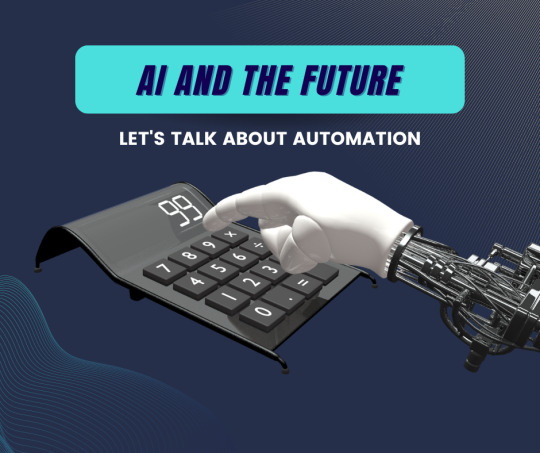
H3: Automation within the Constraints of a Busy Schedule; The background of the issue of doing day-to-day activities faster and easier The era of smart homes and personal assistants is here, and society is embracing it. H3: Employment of the AI and the Automation: Effect of AI and Automation on The Enrichment of Jobs The Emergence of New Types of Occupations. H2: Top 5 Industries Revolutionized by AI at Present: 1. Healthcare 2. Manufacturing 3. Finance 4. Retail 5. Education H3: Use of AI for Enhancing Health Systems: AI that predicts and develops recommendations and plans for treatment Roles played by robots when it comes to surgery processes
H3: AI in the Manufacturing Industry: The Future of Manufacturing: Smart Factories Preferably with Robotism, Automated Warehouses, etc. Conclusion: Other aspects eased by modern technologies H3: AI’s Impact on Finance: This Part Demonstrates the Influence of AI on Financial Activities Facilitated by Artificial Instrumental Advantages. For instance, telemarketing correspondent inquiries. H3: AI in Retail: The configuration of retail strategy and value chain strategy is reflected in the adjusted supply chain architecture. In Conclusion. H3: AI in Education: Extends to current applications of AI in education..
Be informed, Be ahead! Click here join World News Update and always be informed of the progress in... AI.
Benefits and Costs: Current Challenges: Possibilities of Job Losses and the Skills Required H2: AI and Automation in the Near Future: Prospects and Possibilities for the Next Five Years Improving firms in incorporation of these concepts in the industry. The SWOT
H2: Conclusion:
Summarizes the impact of AI and automation within the context of ‘2024’. What should be done and what is to be done next? H2: FAQs: What about the question regarding automation—how it is changing the employment sector? Can technology ever fully eradicate the need for human workers?
What are the common functions that, however, are these days being performed by automated labor? What are the opportunities that technology offers, especially for independent enterprises? What skills do people should acquire or develop to have a chance of being effective at work? Introduction.
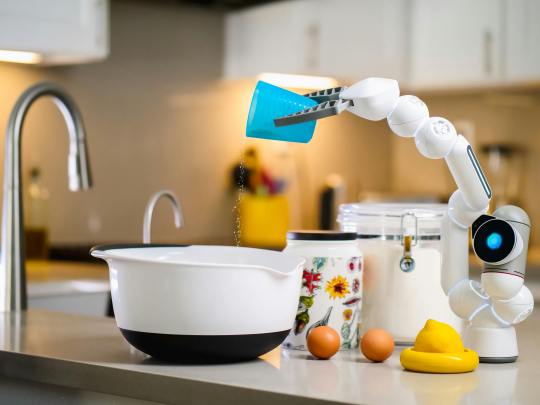
Everyone has been and is hearing a lot of talk about self-driving cars and robots taking over people's work for a few years now. However, as crazy as the idea of them is, in 2024 it is no longer just things we hear; they are actually happening. Everything from turning around businesses to finding a place to sleep at night, there is no doubt about it that these advancements are changing everything we know about the world. Therefore, changes like this are very important.
For this paper, we will expound on the revolutionary ways through which artificial intelligence as well as automation is taking a grip of the year 2024, the sectors most hit, and what features the future will bring. Shall we begin?
Do Not Let the AI Wave Get You Thin! Subscribe with World News Update for a more comprehensive cover on ai.
The Evolution of AI in 2024: Considering the way artificial intelligence has grown, its impact in 2024 is. Not even at the present could these industries and the advancement in AI afford to be separated. Important Breakthroughs in AI: Artificial intelligence is now not a thing of the past, for it is advancing right in 2024 from the point of sophistication and attention. AI assistive technology has revolutionized many a task. Automation of Everyday Businesses: Not only our economic perspective alters with the present progression toward automation but also other aspects of our lives. It’s true even for children’s toys. The Emergence of High-Tech Homes and Robo-Manservant: Think of being back in your house all day only to find out that your house knows all that stuff and even knows the choice of the music that you love playing. With smart houses, it is no longer a figure of speech. It is social reality. Alexa and Google Assistant are ever-present smart helpers in our habits and routines, allowing us to organize our day-to-day routine in a more efficient way.
Partake in the Age of Artificial Intelligence! click and join Health Tips by 90s Mantor0 and literary be at the edge of the sea in terms of AI and automation. The Future of Employment: There is no doubt that the ways in which work is done have been dramatically changed due to technology. Therefore, what was being done by hand in the past is today done by machines. Current and emerging trends on AI and its impacts on the job market; Robots are being used more and more for routine activities, which humans can then stop doing and start on other tasks that are more stimulating or more strategic. For such employees, they should not only be open to such opportunities and paths but should offset the tremendous technological advances that continue to require people to seek new skills and competencies to remain employable. The Top 5 Sectors That Are About to Experience a Revolution As a Result of AI Now it is time to consider the use of AI and automation in specific sectors: 1. Medication Industry: The field of medicine is currently being revolutionized by AI, which aims at creating backing for the work of doctors and also to benefit patients. AI-Driven Diagnostics and Treatment Schemes: AI has the ability to diagnose patients better and more accurately in a fraction of human performance time. Therefore, it can be used to deliver diagnostics and treatment plans to the place where the patients are in real-time. The Role of Robots in Surgery:
The practice of robotic surgery has gained popularity as it assists in making accurate cuts and reduces the recovery period and healing process. 2. Production: Artificial intelligence has also been introduced in industries to make the manufacturing process faster. Smart factories and automated robots. The factories have the artificial intelligence-programmed robots doing works such as quality inspection and assembling and also carrying out predictive maintenance strategies that ensure all the machines are up all day long. 3. Finance: The financial sector has made a step in the integration of artificial intelligence, ranging from auto-trading to fraud detection and even risk management. AI-driven trading platforms: These computer programs can process a lot of data much faster than the human brain and make decisions in split seconds for quite profitable trades in the financial markets while reducing the chances of human intervention errors. 4. Retail: It's no mystery that AI is having a massive influence on modern-day retail by enhancing consumer pleasure and hands-free inventory approaches. Personalized Shopper Experience Retailers are leveraging AI to make hyper-personal product suggestions; this ensures that customers always enjoy unique buying encounters based on the details available about them. 5. Education: AI is used to provide tailored learning experiences in education by assisting students and educators in the process of implementing education according to the specifics of students’ individual abilities and needs. AI: A Crucial Component in the Learning Process: Gone are the days when a teacher would have to explain first, then organize tasks and correct, then/or thereafter feed students information. Thanks to AI, a teacher can tell where all the students are stuck and, without struggling, give each student a lesson tailored to address what problem he or she may be having at that particular time. Advantages and disadvantages of AI and automation: Nevertheless, AI and automation have some weaknesses as well. Operating Cost Effectiveness and Time Savings By using AI, companies can get busy with scaled activities while still doing repetitive work of the staff. At the same time, it offers the improvement of the company’s operations as well as considerably lower inputs. Future Work and Age-Related Job Loss Occurred along with the Skills Lost One of the negative consequences of this is also the fear that dynamic changes in the area of AI quite often result in job understating. AI with Automation in the Near Future: The following question pertains to the future of AI and how long people will learn and actually utilize it. What will happen in the next few years? If more capabilities of AI technology are used—this one even more in such areas as health, industry, and finance. We may also experience autonomous vehicles, smart cities, and AI-driven infrastructure components working at the core of everyday life. Trends and Technologies on the Rise: Most of the up-and-coming fads revolve around the more advanced development of quantum computing and the concepts of ethics surrounding the applications of AI to adjust it in a way that is of significant advantage to everyone’s wellbeing. In conclusion.
Read more>>>>>>>>>>
#AI in 2024#automation trends#artificial intelligence#future of work#smart technology#impact of AI#automation in industry.
3 notes
·
View notes
Text
The second article says that 85 million jobs in the US will be lost to AI by 2025., and over 50% of jobs will eventually be done by AI. It also says it will create more jobs than it destroys which I think is BULLSHIT. It will end up being capable of almost every job that doesn't require a physical presence, including coding jobs like the ones held by the people who fucking created it.
The 2nd Great Depression is going to happen almost exactly 100 years after the first. At its height the unemployment rate then was 25% in the US. Imagine it being 50%.
Even if governments eventually outlaw it, which most won't including the US, companies will just move their HQs to countries where it's legal. I don't know what people are going to do.
If you are looking to change careers or just starting out, seriously consider going to trade school because those fields are looking for people, and blue collar, service jobs, and healthcare are going to be the few sectors left IMO.
36 notes
·
View notes
Text
Artificial intelligence
Computerkeeda
AI is more than just a catchphrase; it’s a driving force behind a significant shift in the way we live. Artificial intelligence is influencing everything, from industry to our moral standards. Let us examine the ramifications of artificial intelligence today, avoiding technical jargon. The labor economy is about to change because of AI. Automation may make certain jobs obsolete, but it also opens up new possibilities. Imagine a society in which routine jobs are mechanized, allowing people to be more innovative and creative. But this change necessitates a change in training and abilities. As workers adjust to rapidly changing technological environments, lifelong learning will become the standard. Our day-to-day existence is also changing. We’re just getting started with smart homes, customized services, and cutting-edge healthcare. The ease with which these advancements bring about raises the question of how to reconcile efficiency with the preservation of human touch and connection. The development of AI raises important moral conundrums. Privacy is a serious issue. Since data is the foundation of contemporary technology, how can we make sure that our personal data is secure? Developing strong frameworks that protect privacy without impeding innovation is the difficult part. Fairness and bias are equally urgent problems. Because AI systems are frequently taught based on historical data, preexisting biases may be reinforced. Constant attention to detail and a dedication to inclusion are necessary to guarantee that these systems are just and equal. Accountability is yet another intricate matter. Who has the responsibility for decisions made by an AI-driven system? The AI itself, or its designers and users? In order to increase confidence in these systems, it is imperative to establish distinct lines of responsibility. The emergence of AI compels us to reexamine basic philosophical issues. What does intelligence really mean? Are robots only copying human behavior, or are they capable of true consciousness? These inquiries put our conceptions of awareness and intellect to the test and force us to carefully consider what it is that makes us human. Making decisions is an additional topic of interest. Emotions, morality, and intuition are frequently factors in human decision-making. What is the comparison between choices made by machines? Can we put our confidence in robots to make financial, legal, and healthcare decisions? Investigating these issues can yield important information about how people and robots will interact in the future. We can only hypothesize about how society may change in the future as a result of AI. Will we see a dystopia in which humankind is controlled by its own inventions or a paradise in which technology improves every aspect of our lives? It is essential to be aware and involved in order to navigate this unpredictable future. We can better prepare for the changes that artificial intelligence (AI) will bring about and make sure that technology works for mankind rather than against it by being aware of the wider implications of AI.
1 note
·
View note
Text
Emerging Industries: Opportunities in the UK Job Market
Planning to study in the UK? Want to explore career opportunities in the United Kingdom?
In the ever-evolving world, the UK stands as a hub for innovation and growth, bringing numerous emerging sectors that offer promising career prospects. As technology continues to reshape the global economy, several industries in the UK have captured attention, presenting exciting opportunities for job seekers and entrepreneurs alike. Take a look at some of the career opportunities you could take advantage of.
1. Fintech (Financial Technology)
The UK has strengthened its position as a leading fintech hub, with London being a prominent center for financial innovation. Fintech includes a wide array of sectors, including mobile payments, blockchain, and cybersecurity. Job opportunities in this field span software development, data analysis, financial consultancy, and regulatory compliance.
2. Technology and IT
In the emerging era of the digital world, technology continues to dominate businesses worldwide. As, a result the demand for technologically advanced professionals tends to rise. Software developers, data analysts, cybersecurity experts, and artificial intelligence specialists roles are in high demand. With the increasing use of technologies and the need for innovative solutions, these roles offer tremendous growth opportunities and competitive salaries.
3. Healthtech
The combination of healthcare and technology has given rise to HealthTech, a sector dedicated to enhancing medical services through innovative solutions. From telemedicine to health analytics and AI-driven diagnostics, HealthTech offers diverse career paths for healthcare professionals, software developers, data scientists, and researchers.
4. Renewable energy and sustainability
With an increased focus on sustainability and combating climate change, the UK has been investing significantly in renewable energy sources. Wind, solar, and hydroelectric power are among the sectors experiencing rapid growth. Job roles in renewable energy range from engineering and project management to research and policy development, catering to those passionate about environmental conservation.
5. Cybersecurity
With the increasing frequency of cyber threats, the demand for cybersecurity experts is on the rise. Businesses and governments are investing heavily in safeguarding digital infrastructure. Job roles in cybersecurity encompass ethical hacking, network security, data protection, and risk analysis, presenting ample opportunities for skilled professionals in this field.
6. Artificial Intelligence and Machine Learning
AI and machine learning are revolutionizing various industries, including finance, healthcare, and manufacturing. The UK is fostering innovation in AI research and development, offering roles in AI programming, data engineering, robotics, and AI ethics.
7. Creative industries
The UK has a rich heritage in the creative sector, encompassing fields like media, design, gaming, and entertainment. Roles in creative industries span from content creation and graphic design to video production and game development, appealing to individuals with artistic and technical skills.
In conclusion, the UK job market is filled with opportunities within emerging industries, showing the nation's commitment to innovation and progress. Whether one's passion lies in sustainability, technology, healthcare, or creative endeavors, these sectors offer an array of possibilities for career growth and contribution to shaping the future.
By embracing change, acquiring relevant skills, and staying adaptable, individuals can position themselves to thrive in these dynamic and promising industries, contributing to both personal success and the advancement of these transformative sectors in the UK.
If you are struggling to get the right guidance, please do not hesitate to consult MSM Unify.
At MSM Unify, you can explore more than 50,000 courses across 1500+ educational institutions across the globe. MSM Unify has helped 1,50,000+ students achieve their study abroad dream so far. Now, it is your turn to attain your study-abroad dreams and elevate your professional journey! So, get ready to broaden your horizons and make unforgettable memories on your upcoming adventure.
2 notes
·
View notes
Text
Trends in AI & Generative AI: Insights from The 2023 AI Summit New York
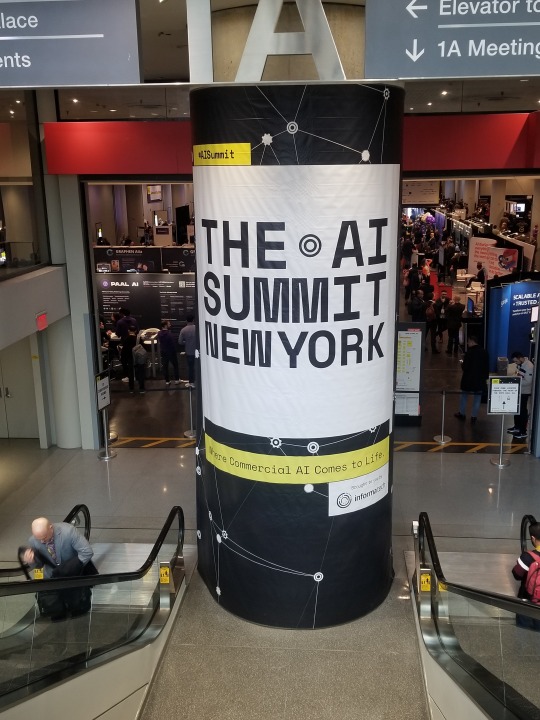
Last week, I covered the AI Summit in New York. I was excited to learn about the trends in AI and generative AI and to see some commercial applications of these new technological advancements.
Patrick Murphy of UAB led the AI Exhibitor hub. Patrick shared insights from his research on Entrepreneurship. He shared how start-ups use AI, and Generative AI to scale up and bring products to market.
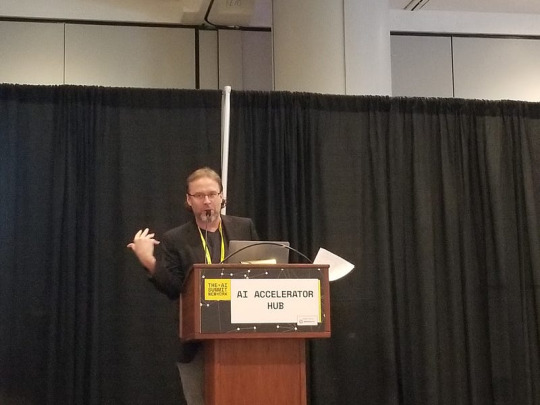
Generative AI is being used in the following eight ways:
Content and Asset Generative
Automated Processes
Ideation
Financial Management
Project Design
Optimized Structures
Acceleration and incubation
Ethics and Risk Management.
There was a pitching completion where start-ups did pitches in multiple rounds. At the beginning of the competition, they received advice from judges on best practices.

One of the start-ups that was of interest was Botwise. Jan Nowak shared how his team shared a use case on how they leveraged Language Learning models (LLM)using statistics and GPT solutions for rapid automation in customer service for Mylead.global is a platform that allows influencers to earn money. As a result, MyLead.global was able to screen influencers faster and better for their big brand clients.
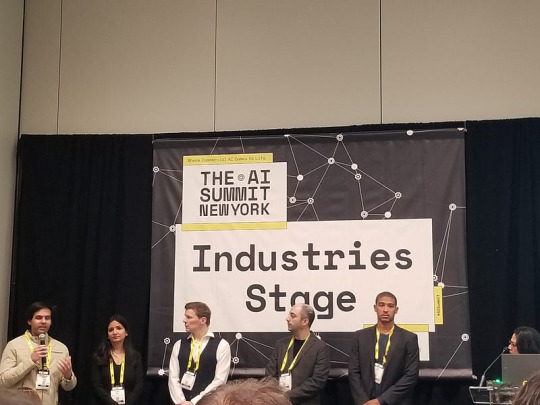
AI-Powered Use Cases from across the board panel discussion
Leaders Saira Kazmi Ph. D. (CVS Health), Matthew Blakemore (Creative Industries Council) Taha Mokfi (HelloFresh), Kriti Kohli (Shopify), and Kris Perez (Data Force) share how they use chatbots, improving both the buyer and seller experience using AI. How AI can be used in video games to identify levels of violence and how AI can improve in healthcare and Radiology reducing the amount of time images are read while improving accuracy and detail.
Another interesting Panel was by Tim Delesio CTO of techolution
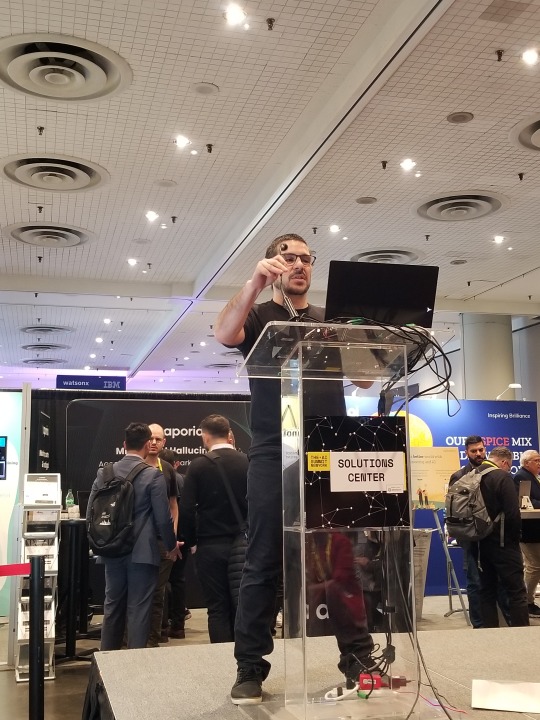
Tim asked What’s driving the explosive rise of AI all of a Sudden?
The answer is the economics of the labor market.
On the demand side, he cited labor shortages and persistent high inflation.
On the supply side, he cites the rise of ChatGPT and, major scientific and Technological breakthroughs in the past five to seven years.
He shared trends in AI for 2024 that include:
Physical Labor with AI to help deliver small batch sizes with high-precision quality control
Improved customer engagement by providing a new generation of customer service agents using Generative AI
Tim demonstrated some of these trends when he ordered a soda using an AI-powered robotic arm.
youtube
The booth had another machine showing how AI can enhance inventory management when items are ordered.
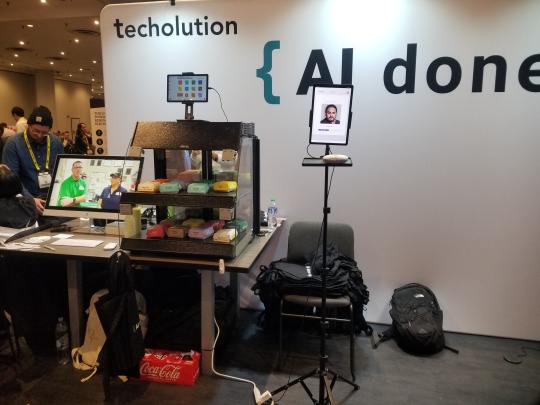
I was amazed to see some AI Tech that techolution brought to the marketplace.
On that note, I saw an AI-powered Kiosk by Graphen where a man ordered his food and paid. This company is using AI to revolutionize all industries.
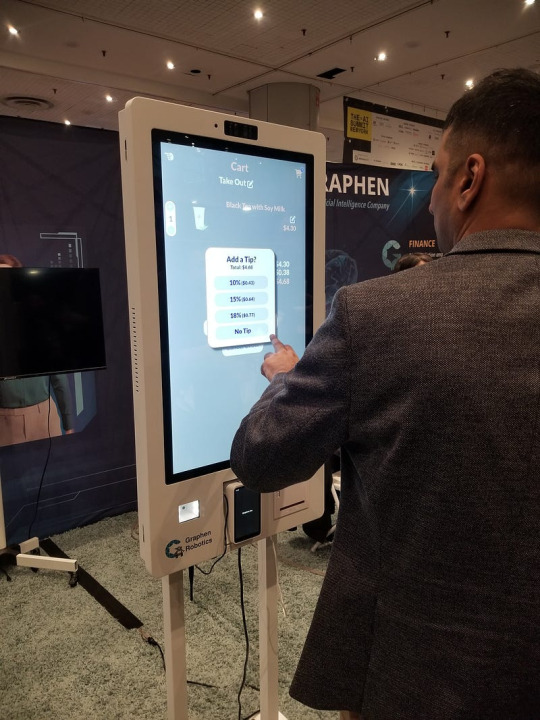
Man orders food AI Kiosk
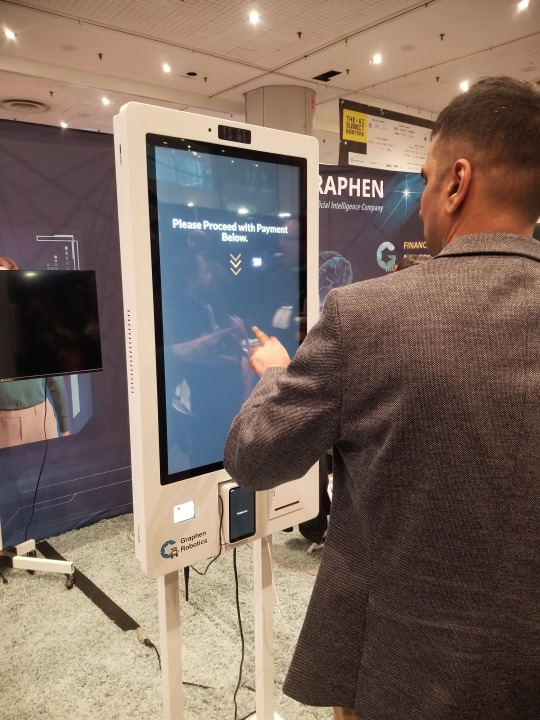
Man pays for food at AI Kiosk
There were so many great talks and exhibits.
youtube
Additional pictures can be found on Instagram.
I want to thank the AI Summit for having me as their guest. If you want to use AI and Generative to improve business outcomes, sign up for the AI summit in your city.
What do you think is next for AI and Generative AI?
Comment and share below.
Additional pictures can be found on Instagram.
5 notes
·
View notes
Text
Technology is constantly evolving, and it's changing the way we live our lives in countless ways. From the smartphones we carry in our pockets to the robots that build our cars, technology is all around us. In this article, we'll take a closer look at some of the ways that technology is impacting our lives.
One of the most significant ways that technology is changing our lives is through the rise of artificial intelligence. AI is a field of computer science that focuses on creating machines that can perform tasks that typically require human intelligence, such as learning, problem-solving, and decision-making.
AI is already being used in a wide range of industries, from healthcare to finance to transportation. For example, self-driving cars use AI to navigate the roads, while AI-powered chatbots are becoming increasingly common in customer service roles.
Another area where technology is having a major impact is in healthcare. Medical technology has advanced by leaps and bounds in recent years, with new treatments and devices being developed all the time. For example, robotic surgery allows doctors to perform minimally invasive procedures with greater precision, while wearable devices can monitor patients' health in real-time.
Technology is also transforming the way we work. Thanks to advances in communication technology, many people now work remotely or have flexible schedules. This has made it possible for people to work from anywhere in the world, which has the potential to change the way we think about work and life balance.
Of course, technology is not without its challenges. One of the biggest concerns is the impact that technology is having on jobs. As machines become more capable, there is a risk that they could replace human workers in many industries. This could lead to significant social and economic upheaval, and it's something that we need to be aware of as we continue to develop new technologies.
In conclusion, technology is having a profound impact on our lives, and it's changing the world in ways that we never could have imagined just a few decades ago. As we continue to explore the possibilities of technology, it's important to consider the potential benefits and risks and to work together to create a future that works for everyone.
#tech#innovation#gadgets#futuretech#digital#technews#techtrends#computerscience#coding#programmerlife#robotics#cybersecurity#artificialintelligence#virtualreality#bigdata#machinelearning#internetofthings#smarttechnology#techreview#smartphone
10 notes
·
View notes
Text
Generative AI in Healthcare Market to Grow at an 35.1% CAGR Till 2032!
The global Generative AI in Healthcare Market worth USD 1.07 billion in 2023 is likely to be USD 21.74 billion by 2032, growing at a 35.1% CAGR between 2023 and 2032.
According to the stats published by World Health Organization (WHO), approximately 1.28 million adults (between 30 and 79 years of age) have hypertension. Of these, as little as 42% of adults are diagnosed and treated correctly and the remaining population is unaware of this condition. The majority of this population resides in low to middle-income countries of the world. Despite this substantial number of untreated cases, the rising awareness among doctors and the general population regarding health illnesses associated with hypertension is expected to drive the demand for the required devices.
Download White Paper@ https://www.towardshealthcare.com/personalized-scope/5069
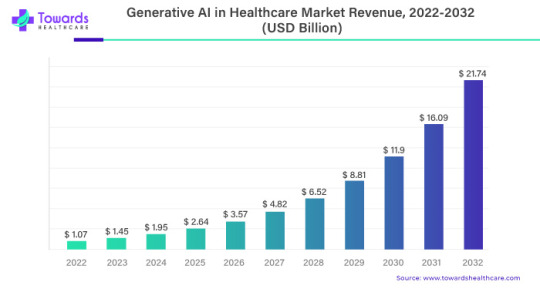
A recent report provides crucial insights along with application based and forecast information in the Global Generative AI in Healthcare Market. The report provides a comprehensive analysis of key factors that are expected to drive the growth of this Market. This study also provides a detailed overview of the opportunities along with the current trends observed in the Generative AI in Healthcare Market.
A quantitative analysis of the industry is compiled for a period of 10 years in order to assist players to grow in the Market. Insights on specific revenue figures generated are also given in the report, along with projected revenue at the end of the forecast period.
Report Objectives
To define, describe, and forecast the global Generative AI in Healthcare Market based on product, and region
To provide detailed information regarding the major factors influencing the growth of the Market (drivers, opportunities, and industry-specific challenges)
To strategically analyze microMarkets1 with respect to individual growth trends, future prospects, and contributions to the total Market
To analyze opportunities in the Market for stakeholders and provide details of the competitive landscape for Market leaders
To forecast the size of Market segments with respect to four main regions—North America, Europe, Asia Pacific and the Rest of the World (RoW)2
To strategically profile key players and comprehensively analyze their product portfolios, Market shares, and core competencies3
To track and analyze competitive developments such as acquisitions, expansions, new product launches, and partnerships in the Generative AI in Healthcare Market
Companies and Manufacturers Covered
The study covers key players operating in the Market along with prime schemes and strategies implemented by each player to hold high positions in the industry. Such a tough vendor landscape provides a competitive outlook of the industry, consequently existing as a key insight. These insights were thoroughly analysed and prime business strategies and products that offer high revenue generation capacities were identified. Key players of the global Generative AI in Healthcare Market are included as given below:
Generative AI in Healthcare Market Key Players:
Syntegra
NioyaTech
Saxon
IBM Watson
Microsoft Corporation
Google LLC
Tencent Holdings Ltd.
Neuralink Corporation
OpenAI
Oracle
Market Segments :
By Application
Clinical
Cardiovascular
Dermatology
Infectious Disease
Oncology
Others
System
Disease Diagnosis
Telemedicine
Electronic Health Records
Drug Interaction
By Function
AI-Assisted Robotic Surgery
Virtual Nursing Assistants
Aid Clinical Judgment/Diagnosis
Workflow & Administrative Tasks
Image Analysis
By End User
Hospitals & Clinics
Clinical Research
Healthcare Organizations
Diagnostic Centers
Others
By Geography
North America
Europe
Asia-Pacific
Latin America
Middle East and Africa
Contact US -
Towards Healthcare
Web: https://www.towardshealthcare.com/
You can place an order or ask any questions, please feel free to contact at
Email: [email protected]
About Us
We are a global strategy consulting firm that assists business leaders in gaining a competitive edge and accelerating growth. We are a provider of technological solutions, clinical research services, and advanced analytics to the healthcare sector, committed to forming creative connections that result in actionable insights and creative innovations.
#seo marketing#seo#market analysis#market share#marketing#ai#artificial intelligence#Generative AI#healthcare
2 notes
·
View notes
Text
The Future of Semiconductors: Unveiling a World of Possibilities
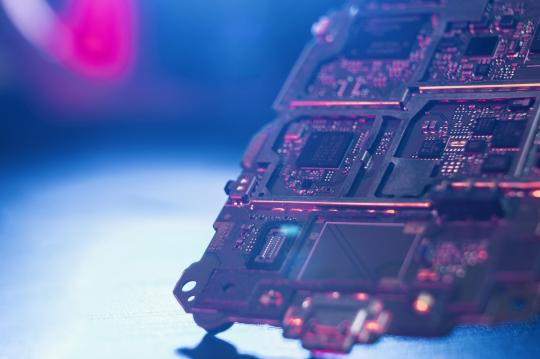
**The Future of Semiconductors: Unveiling a World of Possibilities**
As we stand on the brink of a new era, the semiconductor industry finds itself at the heart of a technological revolution. The impact of semiconductors on our lives has been profound, driving advancements across industries and shaping the very fabric of our modern civilization. But what lies ahead for this dynamic and transformative field? Let's delve into the future of semiconductors and the boundless possibilities that await us.
**1. Quantum Leap in Computing:**
The race towards quantum computing is intensifying, and semiconductors will play a pivotal role in unlocking its true potential. Quantum processors, built on novel semiconductor materials, have the power to process vast amounts of data in a fraction of the time it takes traditional computers. The future of computing will transcend current limitations, empowering us to solve complex problems previously deemed insurmountable.
**2. AI and Machine Learning:**
The era of artificial intelligence is upon us, and semiconductors will serve as the backbone of AI and machine learning applications. With the growing demand for AI-driven technologies in autonomous vehicles, robotics, healthcare, and more, the semiconductor industry is set to witness an unprecedented surge in AI-focused chip designs. Neuromorphic computing, inspired by the human brain's architecture, could unlock revolutionary AI capabilities, paving the way for cognitive computing and self-learning systems.
**3. The Internet of Things (IoT) Revolution:**
As IoT proliferates, the demand for energy-efficient and high-performance semiconductor devices will skyrocket. We envision a future where billions of interconnected devices communicate seamlessly, facilitated by advanced semiconductor technologies. Ultra-low-power processors, sensors, and wireless communication chips will define the landscape of the IoT revolution, shaping smart cities, wearables, and an interconnected world.
**4. Green and Sustainable Semiconductors:**
Sustainability will be a driving force in the semiconductor industry's future. Innovations in materials and manufacturing processes will lead to environmentally friendly and energy-efficient semiconductor solutions. From eco-friendly chip packaging to renewable energy-powered fabs, the industry will strive to minimize its carbon footprint, contributing to a greener tomorrow.
**5. Silicon Photonics and Beyond:**
The integration of photonics with silicon promises a new era of ultra-high-speed data transmission and processing. Silicon photonics will revolutionize data centers, enabling faster communication between chips and reducing data bottlenecks. Moreover, emerging technologies like 2D materials and carbon nanotubes offer exciting possibilities for futuristic semiconductor devices that could outperform traditional silicon-based chips.
**6. Security and Privacy:**
With the increasing dependence on connected devices, security and privacy will be paramount. Future semiconductor designs will prioritize hardware-based security features to protect against cyber threats and safeguard sensitive data. Trusted execution environments and secure enclaves will become integral components of semiconductor devices, ensuring user confidence in an interconnected world.
**7. Global Collaboration and Talent Development:**
The future of semiconductors will thrive on global collaboration and talent development. International partnerships will foster innovation, as countries pool their resources and expertise. Companies will invest in nurturing a diverse and skilled workforce, driving advancements and promoting a culture of inclusion and creativity.
The future of semiconductors is bright, brimming with possibilities that have the potential to redefine our world. As innovators, engineers, and visionaries, let's embrace this transformative journey together. Let's harness the power of semiconductors to build a future that empowers, connects, and inspires generations to come.
*The future is here, and it's in the hands of those who dare to dream and innovate with semiconductors as their guiding light.*
2 notes
·
View notes
Text
Everything You Need to Know About Machine Learning
Ready to step into the world of possibilities with machine learning? Learn all about machine learning and its cutting-edge technology. From what do you need to learn before using it to where it is applicable and their types, join us as we reveal the secrets. Read along for everything you need to know about Machine Learning!

What is Machine Learning?
Machine Learning is a field of study within artificial intelligence (AI) that concentrates on creating algorithms and models which enable computers to learn from data and make predictions or decisions without being explicitly programmed. The process involves training a computer system using copious amounts of data to identify patterns, extract valuable information, and make precise predictions or decisions.
Fundamentally, machine Learning relies on statistical techniques and algorithms to analyze data and discover patterns or connections. These algorithms utilize mathematical models to process and interpret data. Revealing significant insights that can be utilized across various applications by different AI ML services.
What do you need to know for Machine Learning?
You can explore the exciting world of machine learning without being an expert mathematician or computer scientist. However, a basic understanding of statistics, programming, and data manipulation will benefit you. Machine learning involves exploring patterns in data, making predictions, and automating tasks.
It has the potential to revolutionize industries. Moreover, it can improve healthcare and enhance our daily lives. Whether you are a beginner or a seasoned professional embracing machine learning can unlock numerous opportunities and empower you to solve complex problems with intelligent algorithms.
Types of Machine Learning
Let’s learn all about machine learning and know about its types.
Supervised Learning
Supervised learning resembles having a wise mentor guiding you every step of the way. In this approach, a machine learning model is trained using labeled data wherein the desired outcome is already known.
The model gains knowledge from these provided examples and can accurately predict or classify new, unseen data. It serves as a highly effective tool for tasks such as detecting spam, analyzing sentiment, and recognizing images.
Unsupervised Learning
In the realm of unsupervised learning, machines are granted the autonomy to explore and unveil patterns independently. This methodology mainly operates with unlabeled data, where models strive to unearth concealed structures or relationships within the information.
It can be likened to solving a puzzle without prior knowledge of what the final image should depict. Unsupervised learning finds frequent application in diverse areas such as clustering, anomaly detection, and recommendation systems.
Reinforcement Learning
Reinforcement learning draws inspiration from the way humans learn through trial and error. In this approach, a machine learning model interacts with an environment and acquires knowledge to make decisions based on positive or negative feedback, referred to as rewards.
It's akin to teaching a dog new tricks by rewarding good behavior. Reinforcement learning finds extensive applications in areas such as robotics, game playing, and autonomous vehicles.
Machine Learning Process
Now that the different types of machine learning have been explained, we can delve into understanding the encompassing process involved.
To begin with, one must gather and prepare the appropriate data. High-quality data is the foundation of any triumph in a machine learning project.
Afterward, one should proceed by selecting an appropriate algorithm or model that aligns with their specific task and data type. It is worth noting that the market offers a myriad of algorithms, each possessing unique strengths and weaknesses.
Next, the machine goes through the training phase. The model learns from making adjustments to its internal parameters and labeled data. This helps in minimizing errors and improves its accuracy.
Evaluation of the machine’s performance is a significant step. It helps assess machines' ability to generalize new and unforeseen data. Different types of metrics are used for the assessment. It includes measuring accuracy, recall, precision, and other performance indicators.
The last step is to test the machine for real word scenario predictions and decision-making. This is where we get the result of our investment. It helps automate the process, make accurate forecasts, and offer valuable insights. Using the same way. RedBixbite offers solutions like DOCBrains, Orionzi, SmileeBrains, and E-Governance for industries like agriculture, manufacturing, banking and finance, healthcare, public sector and government, travel transportation and logistics, and retail and consumer goods.
Applications of Machine Learning
Do you want to know all about machine learning? Then you should know where it is applicable.
Natural Language Processing (NLP)- One area where machine learning significantly impacts is Natural Language Processing (NLP). It enables various applications like language translation, sentiment analysis, chatbots, and voice assistants. Using the prowess of machine learning, NLP systems can continuously learn and adapt to enhance their understanding of human language over time.
Computer Vision- Computer Vision presents an intriguing application of machine learning. It involves training computers to interpret and comprehend visual information, encompassing images and videos. By utilizing machine learning algorithms, computers gain the capability to identify objects, faces, and gestures, resulting in the development of applications like facial recognition, object detection, and autonomous vehicles.
Recommendation Systems- Recommendation systems have become an essential part of our everyday lives, with machine learning playing a crucial role in their development. These systems carefully analyze user preferences, behaviors, and patterns to offer personalized recommendations spanning various domains like movies, music, e-commerce products, and news articles.
Fraud Detection- Fraud detection poses a critical concern for businesses. In this realm, machine learning has emerged as a game-changer. By meticulously analyzing vast amounts of data and swiftly detecting anomalies, machine learning models can identify fraudulent activities in real-time.
Healthcare- Machine learning has also made great progress in the healthcare sector. It has helped doctors and healthcare professionals make precise and timely decisions by diagnosing diseases and predicting patient outcomes. Through the analysis of patient data, machine learning algorithms can detect patterns and anticipate possible health risks, ultimately resulting in early interventions and enhanced patient care.
In today's fast-paced technological landscape, the field of artificial intelligence (AI) has emerged as a groundbreaking force, revolutionizing various industries. As a specialized AI development company, our expertise lies in machine learning—a subset of AI that entails creating systems capable of learning and making predictions or decisions without explicit programming.
Machine learning's widespread applications across multiple domains have transformed businesses' operations and significantly enhanced overall efficiency.
#ai/ml#ai#artificial intelligence#machine learning#ai development#ai developers#data science#technology#data analytics#data scientist#data processing
3 notes
·
View notes